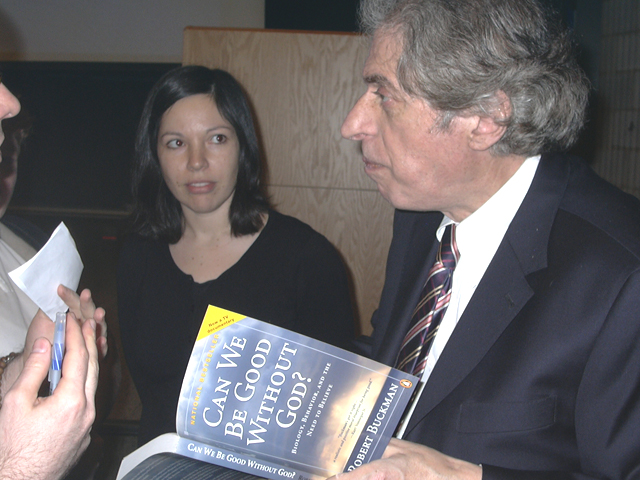The Ghost in the Machine
 It’s dark, quiet – there’s a woman sitting blindfolded in an armchair. On her head is some kind of helmet. She senses the presence of others, maybe even God, at her left side even though she knows there is no one else in the room. When she tries to focus on them, they move around. Although she feels fear, she’s sad when this presence fades away.
It’s dark, quiet – there’s a woman sitting blindfolded in an armchair. On her head is some kind of helmet. She senses the presence of others, maybe even God, at her left side even though she knows there is no one else in the room. When she tries to focus on them, they move around. Although she feels fear, she’s sad when this presence fades away.
The experiment is over.
The MacLeod auditorium was filled beyond capacity last Friday evening to hear the talk entitled, “Belief, Biology and the Human Brain: Is God All in Your Head?” presented by the Toronto Secular Alliance. A raffle held near the end of the evening promised the winner a paid trip to Sudbury to participate in Dr. Michael Persinger’s experiments.
Dr. Persinger, a neuroscientist at Laurentian University, is trying to replicate the God experience using the scientific method. He uses electromagnetic energy to induce sensed presence – the feeling that you’re not alone. He suggests that sensed presence is the prototype for the experience of supernatural beings, from gods to aliens. “Nature’s been doing it forever. We’re not doing anything fancy. All we have done like all science is simply take the scientific method, measure what nature does, duplicate it in the laboratory and then replicate it under controlled conditions.”
In the experiments, subjects sit blindfolded in an armchair in a dark, double-walled metal acoustic chamber to block out light and sound. A modified motorcycle helmet is placed on their heads through which weak, complex magnetic fields are delivered. The fields are first exposed to the right side of the brain, followed by bilateral stimulation. The intensities of the magnetic fields are not the critical factor (they’re well below those produced by the earth), but the content is. The more these fields simulate natural electromagnetic patterns displayed by the brain the lower the intensity required to produce the effect.
As with the woman at the beginning of the article, stimulating the right side of the brain elicited a sensation on the left side of her body. When she tried to focus on the presence it seemed to move because the act of focusing changed her brain activity and how the fields interacted with her brain. When the fields were stopped, the presence disappeared.
Persinger reported that about 80% of subjects experienced a sensed presence. This experience was rarely reported for the control group – people exposed to sham-field conditions. Subjects consisted of students enrolled in first year psychology classes who participated in exchange for extra marks, but the same results have been reported by other volunteers including self-labeled psychics and brain-injury patients. With the latter group, it helps them to realize that presences that have appeared since the injury, which are often thought to be a deceased family member or cultural icon, can be replicated in the lab and do not mean they are “going crazy” as they often feel to be the case.
The sense of self is associated with the left hemisphere of the human brain and by applying a magnetic field with a certain pattern to the right side, Persinger hypothesizes that the right hemisphere also produces an equivalent sense of self. When this is detected by the left hemisphere – this cross-talk between hemispheres is normally inhibited, but bilateral stimulation disrupts this inhibition – the person then experiences a sense of a presence.
A volunteer who had experienced a “haunting” was exposed to specific magnetic field patterns. Persinger’s group was able to replicate the experience, as well as detect a sudden outburst of electrical activity they believed came from the right temporal lobe, an area linked to religious experiences. The right hemisphere is often associated with artistic ability and Persinger pointed out in his talk that introspective individuals are more sensitive to electromagnetic activity. This may be the reason that throughout history creative individuals from different cultures have more frequently reported the presence of a Sentient Being, such as the Muses in Greek mythology.
“Myths are good for learning moral codes,” said Dr. Robert Buckman, the other speaker of the evening, “but we shouldn’t take them literally.” Dr. Buckman is a medical oncologist at the Princess Margaret Hospital and is troubled by the number of people who claim they’d kill if God told them to. In his book, Can We Be Good Without God? he says “Believe whatever you wish but behave as if there were no supernatural beings to sort out our problems.” Whether God exists or not isn’t the issue for Persinger – what is important is that this technology may help identify the area of the brain that generates the experience. Dr. Buckman agrees, “Some people have said that God has developed the right temporal lobe – you can either have it turned on by God or by Persinger.”
Buckman believes it’s important to be aware of the results of Persinger’s research so that you know your right temporal lobe can mislead you. He says that if you know these messages from God might be a product of your brain, you might think twice before picking up a weapon in His name.
Posted by Susan at March 19, 2006 11:48 PM